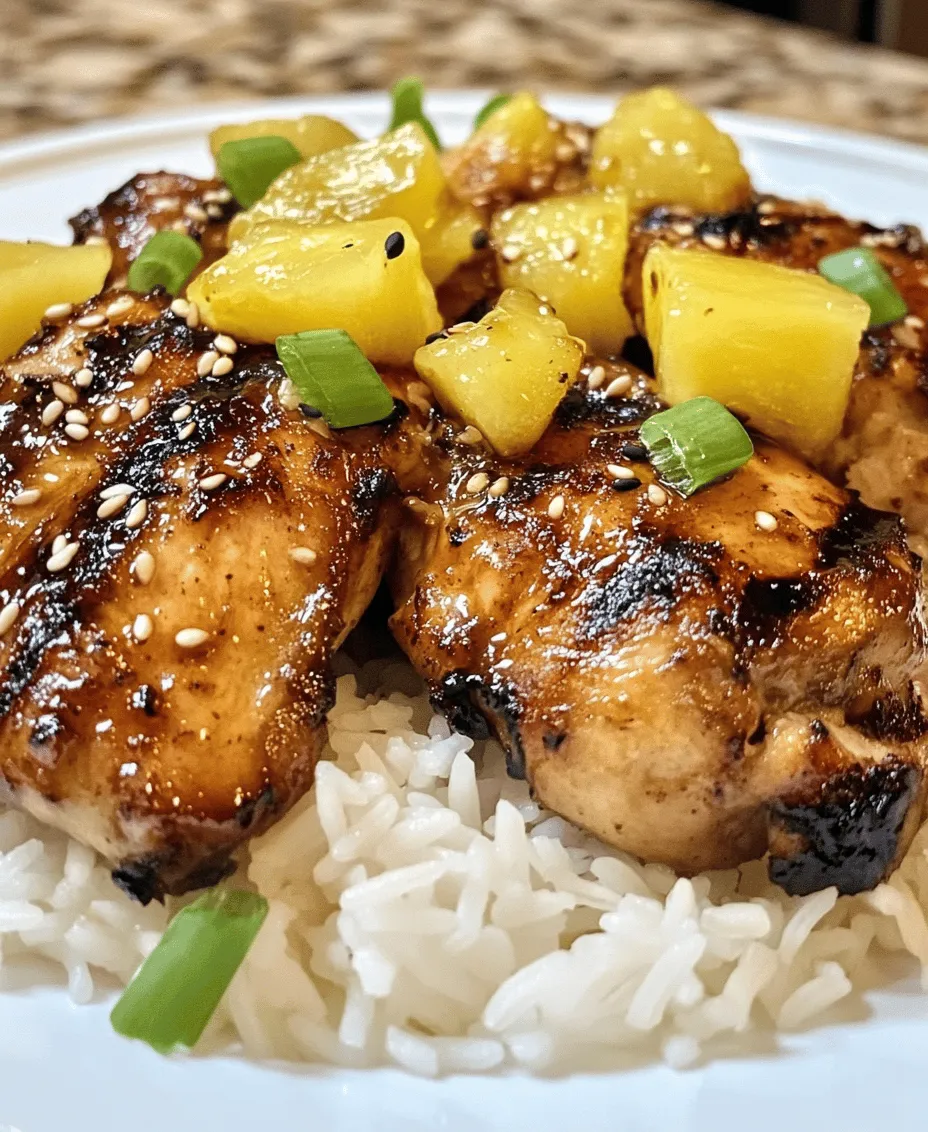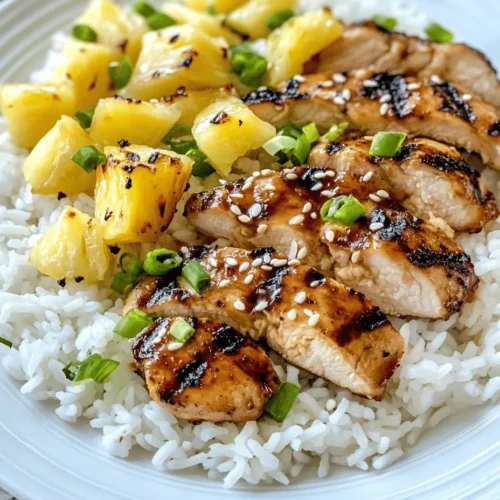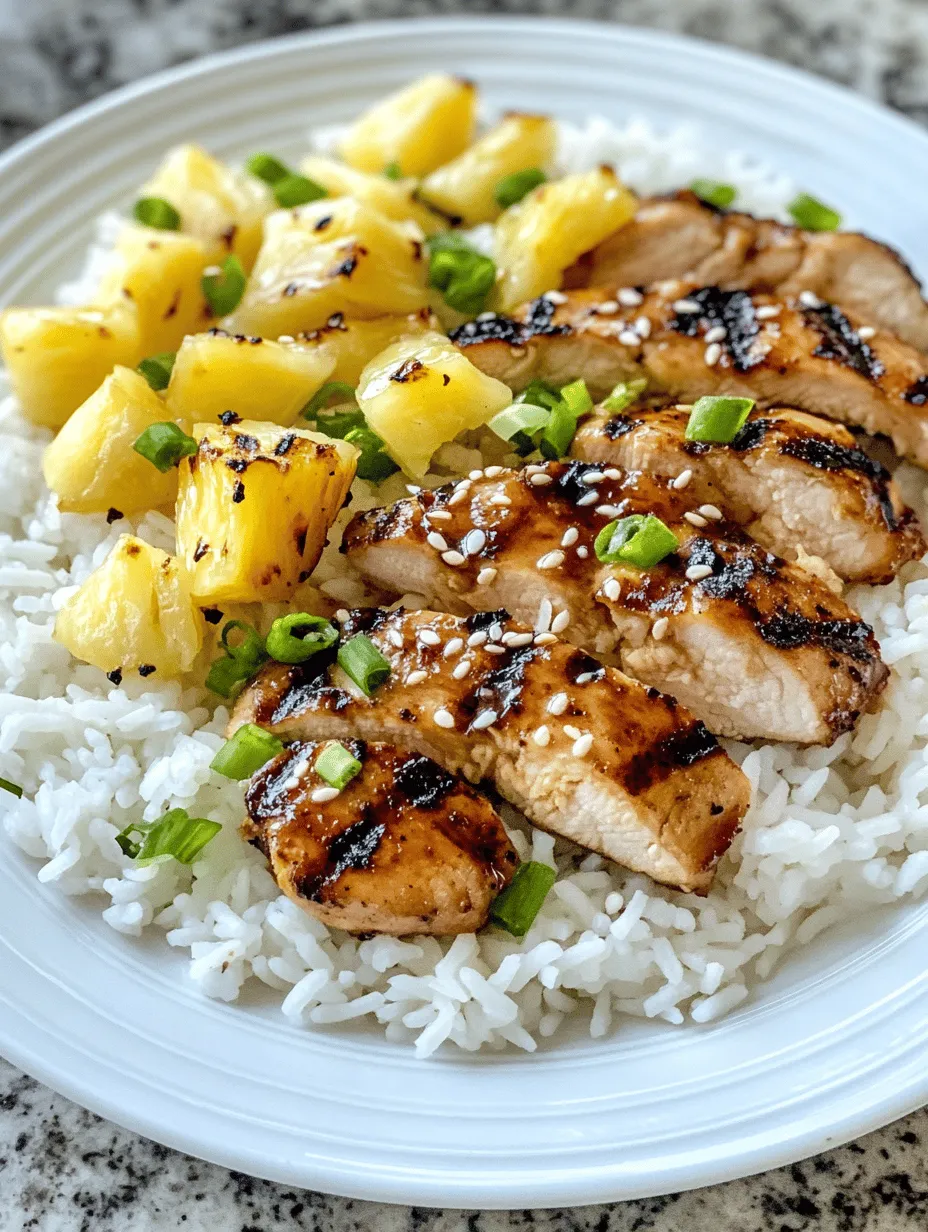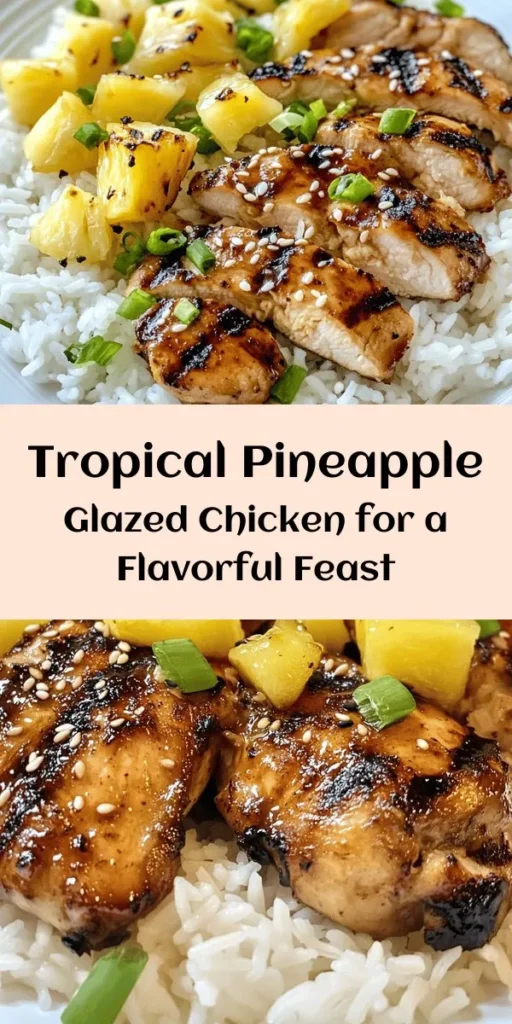Introduction
Tropical cuisine is a vibrant tapestry of flavors that captures the essence of sun-soaked landscapes, lush greenery, and culturally rich traditions. With its fresh ingredients, bold spices, and a harmonious blend of sweet and savory elements, tropical cuisine invites food lovers to embark on a culinary journey reminiscent of paradise. One dish that exemplifies this delightful fusion is the Tropical Pineapple-Glazed Chicken. This recipe is an enticing medley of succulent chicken, zesty pineapple, and a myriad of complementary flavors, making it an ideal choice for family dinners and special occasions alike.
What sets this Tropical Pineapple-Glazed Chicken apart is its ability to transport your taste buds to a sun-drenched beach, even if you’re cooking in your own kitchen. The sweet, tangy glaze not only enhances the natural flavors of the chicken but also adds a tropical twist that is sure to impress your guests. Whether you’re hosting a summer barbecue or simply looking to elevate your weeknight meals, this dish brings a festive flair to any dining experience.
In this article, we will guide you through the ingredients that make up this delicious recipe, followed by detailed preparation steps to ensure you create a mouthwatering plate of Tropical Pineapple-Glazed Chicken that is bursting with flavor.
Understanding the Ingredients
To create the perfect Tropical Pineapple-Glazed Chicken, it’s essential to understand the role each ingredient plays in enhancing the dish’s overall flavor profile. Here, we’ll break down the main components that contribute to this tropical masterpiece.
Boneless, Skinless Chicken Breasts
The backbone of our recipe is boneless, skinless chicken breasts. This choice of meat is not only incredibly versatile but also provides a lean source of protein. Chicken breasts are known for their ability to absorb flavors well, making them an excellent canvas for our pineapple glaze. Additionally, because they cook relatively quickly, they are perfect for busy weeknights or when you’re entertaining guests.
Pineapple Juice
Pineapple juice is a vital ingredient that brings sweetness and acidity to the dish. The natural sugars in the juice caramelize beautifully during cooking, creating a glossy finish that enhances the visual appeal of the chicken. Moreover, the acidity helps to tenderize the meat, resulting in a juicy and flavorful final product. The balance of sweetness from the pineapple juice against the savory elements of the dish creates a delightful contrast that is characteristic of tropical cuisine.
Soy Sauce
Adding depth and umami to the recipe is soy sauce. This fermented ingredient serves as a savory counterpoint to the sweetness of the pineapple juice and brown sugar. The saltiness of soy sauce not only boosts the overall flavor but also enhances the chicken’s natural taste, creating a wonderful balance that leaves you wanting more.
Brown Sugar
Brown sugar plays a crucial role in this recipe by balancing the savory notes with its rich sweetness. As the chicken cooks, the brown sugar melts and caramelizes, forming a delectable glaze that clings to the meat. This caramelization process adds complexity to the dish, making each bite a harmonious blend of sweet and savory.
Fresh Ginger and Garlic
Fresh ginger and garlic are essential aromatics that elevate the flavor profile of the Tropical Pineapple-Glazed Chicken. Ginger adds a warm spiciness, while garlic contributes a robust, pungent flavor that rounds out the dish. Together, these ingredients provide a fragrant base that enhances the overall sensory experience of the meal.
Sesame Oil and Rice Vinegar
To add layers of richness and tanginess, we incorporate sesame oil and rice vinegar. Sesame oil introduces a nutty flavor that complements the sweetness of the glaze, while rice vinegar adds a subtle tang that brightens the dish. This combination of flavors contributes to the complexity of the glaze, ensuring that each bite is a delightful exploration of taste.
Black Pepper and Red Pepper Flakes
For those who enjoy a touch of heat, black pepper and red pepper flakes are excellent additions. These spices introduce a mild kick that awakens the palate without overwhelming the dish. The heat from the red pepper flakes melds beautifully with the other ingredients, adding depth and complexity to the overall flavor profile.
Fresh Pineapple Chunks and Garnishes
Finally, fresh pineapple chunks and garnishes play a dual role in this recipe. Not only do they enhance the visual presentation, bringing bursts of color to your plate, but they also provide a refreshing crunch that contrasts with the tender chicken. Garnishing with chopped green onions or cilantro adds a pop of freshness and elevates the dish, making it not only a feast for the taste buds but also for the eyes.
Preparation Steps for a Flavorful Dish
Now that we’ve explored the ingredients that contribute to the wonderful flavors of our Tropical Pineapple-Glazed Chicken, let’s delve into the preparation steps that will guide you to culinary success. The first and most crucial step in making this dish is marinating the chicken, which significantly enhances its flavor and tenderness.
Marination Process
1. Combine the Marinade: Begin by mixing together the pineapple juice, soy sauce, brown sugar, minced garlic, grated ginger, sesame oil, rice vinegar, black pepper, and red pepper flakes in a large bowl. This mixture will serve as both a marinade and a glaze, so ensure all ingredients are well incorporated.
2. Prepare the Chicken: While the marinade is coming together, take your boneless, skinless chicken breasts and pat them dry with paper towels. Drying the chicken helps the marinade adhere better, ensuring that every bite is infused with flavor.
3. Marinate the Chicken: Place the chicken breasts in the bowl with the marinade, ensuring they are fully coated. Cover the bowl with plastic wrap or transfer the chicken and marinade to a resealable plastic bag for easier handling. Allow the chicken to marinate in the refrigerator for at least 30 minutes, although for the best results, marinating for 2 hours or overnight is recommended. This extended marination time allows the flavors to penetrate the meat deeply, resulting in a more flavorful and tender finished dish.
4. Tips for Achieving the Best Marination Results:
– Use Fresh Ingredients: Fresh garlic and ginger yield more robust flavors than their dried counterparts, so always opt for fresh when possible.
– Don’t Skip the Marinade Time: The longer you marinate, the more flavorful your chicken will be. If you’re short on time, even a 30-minute soak will enhance the taste, but aim for several hours if you can.
– Turn the Chicken: If marinating in a bowl, turn the chicken halfway through to ensure even flavor distribution. If using a plastic bag, massage the contents to coat the chicken thoroughly.
Cooking Methods: Grilling vs. Stovetop Cooking
Once your chicken has marinated to perfection, it’s time to choose your cooking method. Both grilling and stovetop cooking have their pros and cons, and your choice may depend on personal preference or the equipment you have available.
Grilling
Pros:
– Grilling imparts a smoky flavor that elevates the dish, enhancing the tropical experience.
– The high heat of the grill caramelizes the sugars in the marinade quickly, creating a beautiful glaze on the chicken.
Cons:
– Requires outdoor space and suitable weather conditions.
– Can take longer to preheat and manage if you’re not familiar with grilling techniques.
Grilling Tips:
– Preheat your grill to medium-high heat and oil the grates to prevent sticking.
– Allow the chicken to cook for about 6-7 minutes per side, or until the internal temperature reaches 165°F (75°C).
– Use a meat thermometer for accuracy and to avoid overcooking.
Stovetop Cooking
Pros:
– Convenient and accessible for indoor cooking, regardless of weather conditions.
– Easier to control cooking temperature and timing.
Cons:
– May not achieve the same smoky flavor as grilling.
– Requires careful attention to avoid burning the sugars in the marinade.
Stovetop Cooking Tips:
– Heat a large skillet or frying pan over medium-high heat and add a splash of oil.
– Sear the chicken for about 5-6 minutes on each side until golden brown and fully cooked.
– To create a glaze, reserve some marinade and simmer it in the skillet after the chicken is cooked, then drizzle it over the chicken before serving.
Ideal Cooking Techniques for Juicy Chicken
Regardless of your chosen cooking method, here are some techniques to ensure your Tropical Pineapple-Glazed Chicken remains juicy and flavorful:
– Avoid Overcrowding the Pan: If using a stovetop, cook the chicken in batches if necessary to prevent steam from forming, which can make the chicken tough.
– Let it Rest: After cooking, let the chicken rest for about 5 minutes before slicing. This allows the juices to redistribute, keeping the meat succulent and tender.
– Baste for Extra Flavor: If grilling, consider basting the chicken with the reserved marinade during the last few minutes of cooking for an extra layer of flavor.
With these preparation steps and cooking methods in mind, you are well on your way to creating a delicious Tropical Pineapple-Glazed Chicken that will impress your family and friends. In the next part of this article, we will explore serving suggestions, storage tips, and frequently asked questions to ensure you master this delightful dish.

Highlighting the Glazing Process
The glazing process is where the magic truly happens in the Tropical Pineapple-Glazed Chicken recipe. To achieve that glossy, mouthwatering finish, begin by simmering the pineapple juice, brown sugar, soy sauce, and ginger in a saucepan over medium heat. This mixture will reduce and thicken, creating a rich glaze that clings beautifully to the chicken. The key is to allow the glaze to bubble and caramelize, which enhances not only the flavor but also the visual appeal of the dish.
Once the chicken has been grilled or baked to perfection, brush it generously with the warm glaze. Return it to the grill or oven for a few minutes, allowing the heat to set the glaze. This step is crucial as it creates a slightly charred, sticky coating that elevates the dish to new heights. The caramelization of the sugars in the glaze adds complexity, creating a delightful contrast between the sweet, tangy glaze and the savory chicken. As the glaze caramelizes, it forms a beautiful golden crust that enhances the dish’s texture and flavor profile.
The Science Behind Caramelization
Caramelization is a complex chemical reaction that occurs when sugars are heated. This process not only changes the color of the glaze, giving it a beautiful, amber hue, but it also intensifies the flavors by creating new compounds. When sugars break down, they develop a deep, rich taste that can add layers of complexity to your dishes. In the case of the Tropical Pineapple-Glazed Chicken, caramelization enhances the sweetness of the pineapple while balancing it with the savory notes of the chicken and the umami from the soy sauce.
By understanding the science behind this process, home cooks can appreciate the care that goes into achieving a perfectly glazed dish. The balance of heat and time is crucial; too little time and the sugars won’t caramelize, too much, and they may burn. Mastering this technique will not only improve your chicken but also elevate a variety of other dishes, making it a worthwhile skill to develop in the kitchen.
Serving Suggestions and Pairings
When it comes to serving Tropical Pineapple-Glazed Chicken, presentation is key. A vibrant plate can enhance the dining experience, so consider using a large, white platter to showcase the colorful chicken pieces. Arrange the glazed chicken on a bed of fluffy jasmine rice, which acts as a canvas for the dish. The rice’s subtle flavor complements the bold glaze while absorbing any excess sauce.
Garnishing is essential for an inviting presentation. Fresh pineapple chunks can be placed around the chicken for a burst of color and flavor. Additionally, a sprinkle of finely chopped green onions lends a pop of freshness, while sesame seeds introduce a delightful crunch. These fresh ingredients not only enhance the dish’s visual appeal but also add layers of flavor that elevate the overall eating experience.
Suggested Side Dishes
To create a well-rounded meal, consider pairing your Tropical Pineapple-Glazed Chicken with sides that complement its tropical flavors. Jasmine rice is an ideal choice due to its fragrant aroma and slightly sticky texture, which balances the sweetness of the glaze. The rice can be steamed simply or flavored with coconut milk for an even more tropical twist.
For those looking to add freshness to the plate, a tropical salad made with mixed greens, mango, avocado, and a light citrus vinaigrette can be a refreshing counterpoint to the rich glaze. The acidity from the dressing will cut through the sweetness, providing a harmonious balance. Grilled vegetables, such as zucchini, bell peppers, and asparagus, tossed lightly in olive oil and grilled until tender, can also add a wonderful charred flavor that pairs beautifully with the chicken.
Nutritional Benefits of Tropical Pineapple-Glazed Chicken
This Tropical Pineapple-Glazed Chicken recipe is not only delicious but also nutritious. Chicken breast is a fantastic source of lean protein, which is essential for muscle growth and repair. A serving of chicken can provide a substantial amount of protein with relatively low calories, making it a perfect choice for those looking to maintain or lose weight.
Fresh pineapple, a star ingredient in this dish, brings a wealth of nutritional benefits to the table. It is rich in vitamins C and B6, manganese, and dietary fiber. The enzyme bromelain found in pineapple is known for its anti-inflammatory properties and can aid in digestion. Ginger and garlic, included in the glaze, boast additional health benefits, including antioxidant and anti-inflammatory effects.
Balancing indulgence with health is key, and this dish fits seamlessly into a healthy diet. By using fresh ingredients and controlling added sugars in the glaze, home cooks can enjoy the sweetness of this dish without the guilt. The combination of protein, healthy fats from any chosen sides, and the vitamins from the pineapple and vegetables creates a wholesome meal.
Cultural Significance of Tropical Flavors
The ingredients used in this Tropical Pineapple-Glazed Chicken recipe are deeply rooted in various culinary traditions, particularly those of tropical regions like Hawaii and the Caribbean. Pineapple, for instance, is often associated with Hawaiian cuisine, where it is celebrated for its sweetness and versatility. It can be found in dishes ranging from grilled meats to refreshing salads and desserts.
The infusion of tropical ingredients into culinary practices has been influenced by the rich history of trade and migration. The combination of sweet and savory flavors is a hallmark of Caribbean cuisine, where spices and fruits are often harmoniously blended to create vibrant dishes. This recipe not only showcases the delightful taste of these ingredients but also connects home cooks to these rich culinary traditions.
By preparing Tropical Pineapple-Glazed Chicken, you engage in a broader culinary discourse, celebrating the flavors and cooking techniques that have been passed down through generations. It’s a reminder of how food can bridge cultures and bring people together.
Conclusion
In summary, Tropical Pineapple-Glazed Chicken is a delightful and easy-to-make recipe that embodies the essence of tropical flavors. Its caramelized glaze, enriched by fresh ingredients, makes it a standout dish for any occasion. Whether hosting a summer barbecue, preparing a weeknight dinner, or looking for an impressive dish to serve guests, this recipe offers versatility and appeal to diverse palates.
The joy of cooking with fresh, tropical ingredients is not just in the flavors they bring but in the memories and experiences they create. Sharing this dish with loved ones can lead to cherished moments around the dinner table, filled with laughter and enjoyment. Embrace the vibrant tastes of the tropics and let this Tropical Pineapple-Glazed Chicken be the centerpiece of your next culinary adventure.



